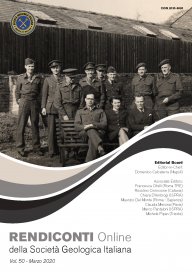
Ricostruzione 3D della distribuzione delle tessiture nel sottosuolo della Pianura Lombarda centro-occidentale
Angelo Cavallin (1), Tullia Bonomi (1), Letizia Fumagalli (1) & Mauro Marchetti (2)
(1) Disat - Dipartimento di Scienze dell'Ambiente e della Terra, Università di Milano Bicocca.
(2) Desu - Dipartimento di Educazione e Scienze Umane, Università di Modena e Reggio Emilia. Corresponding author e-mail: angelo.cavallin@unimib.it
DOI: https://doi.org/10.3301/ROL.2020.01
Volume: 50/2020
Pages: 2-12
Abstract
Po Plain is the result of complex endogenous processes which induced the growth of a large and deep subsiding foredeep basin for the south-vergent thrusting from the Alpine Chain first, and then for the Apennine structure, verging in the opposite direction. The Po Plain foredeep was nourished by large amount of debris coming from exogenous processes of erosion of both mountain chains. During Pleistocene, the foredeep has assumed a W-E direction along the Appenine margin, corresponding to the Po River course, deeper eastward. At the same time, at the northern margin of the plain, isostatic processes have been responsible of relevant raising. Sediments in the area have been deposited firstly in a marine basin, then in a wide delta-lagoon region, and more recently, a continental sedimentation prevailed. The area was dominated by large alluvial fans coming from the main Alpine valleys while in the southern part of the plain, where finer sediments are widespread, intense subsidence phenomena due to compaction of the sedimentary deposits occurred. During Quaternary, fluvial transport and sedimentation was strongly influenced by climate changes and, in the cold stages, large amount of debris were produced on the mountain chains and remarkable sea-level changes caused marine ingression in the middle of the Po Plain alternating to as much relevant regressions. Through the use of GOCAD software, using SGRID frame, voxels 500x500 m were obtained interpolating between Topo and A surfaces subdivided in 90 intervals, between A and B surfaces in 84 intervals and between B and C surfaces in 74 intervals respectively. The surfaces A, B and C, (Regione Lombardia & ENI-Divisione AGIP, 2002) were dated back respectively to 450, 870 and 1240 Ky. In each voxel, gravel, sand and clay texture distribution have been interpolated using percentage of texture for each metre assumed from stratigraphic data of the wells (11,993) stored in TANGRAM database. Interpolation has been carried out using kriging methods into GOCAD environment. To each voxel, the value of texture percentage has been assigned and the distribution in space and time has been modelled. 3D analysis related to clastic deposits distribution in the whole studied area testify that: 1) gravels deposited in the piedmont area over sand and clay materials from MIS 22 (870 Ky), and prograding gradually southward, are the effects of the beginning of glacial phases; 2) sand levels interbedded with clay ones, along the south-eastern Po river axis, have a geometric sequences, along axis Z, according to temporal sequences, effects of climate changes during Pleistocene.
Keywords
Get Full Text